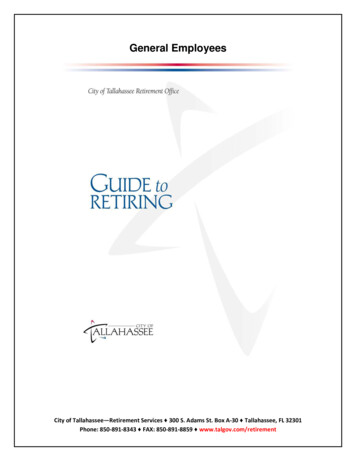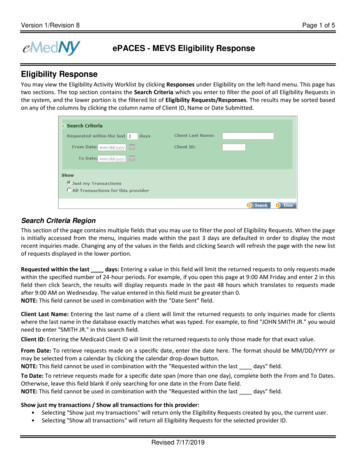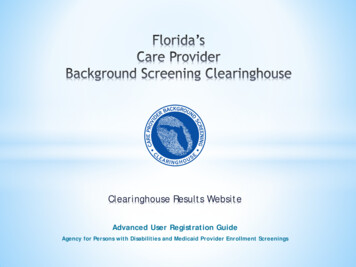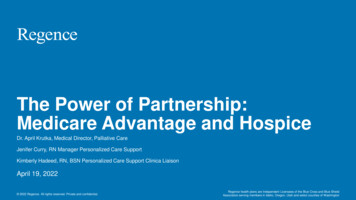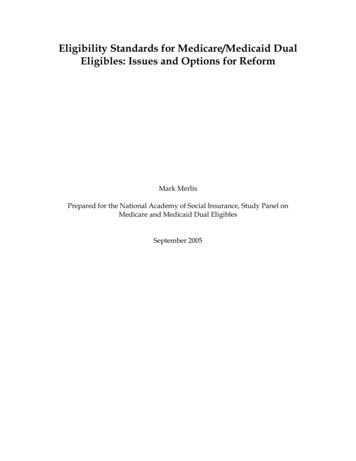
Transcription
Eligibility Standards for Medicare/Medicaid DualEligibles: Issues and Options for ReformMark MerlisPrepared for the National Academy of Social Insurance, Study Panel onMedicare and Medicaid Dual EligiblesSeptember 2005
Table of ContentsIntroduction . 1Data and Methods. 2Current Eligibility Standards . 3Full-benefit eligibility . 3Eligibility for Medicare Savings Programs . 5Eligibility for MMA low-income drug subsidies . 6Income and resource methodologies . 7Key issues in eligibility standards . 9State differences . 9Cliff effects . 12Resource standards. 13Options for Reform . 17Option 1: Uniform methodologies for MSP benefits and drug subsidies . 17Option 2: Align MSP categories with MMA drug subsidy categories. 19Option 3: Annuitized liquid assets . 22Option 4: Combine option 2 with uniform income and asset limits for fullbenefits. 23Conclusion . 26References . 28Appendix A. Methodology. 29Appendix B. State Income Standards, 2001. 31Appendix C. Special Eligibility Rules, 2001 . 34List of TablesTable 1. Major Groups of Full-Benefit Dual Eligibles . 5Table 2. Eligibility and Benefits, Medicare Savings Programs . 6Table 3. Eligibility and Benefits, MMA Low-Income Prescription Drug Subsidies. 7Table 4. State Variation in Percent of Aged and Disabled Medicare Beneficiariesin Poverty Eligible for Full Medicaid Benefits, 2001. 10Table 5. State Variation in Percent of Aged and Disabled Medicare BeneficiariesBelow 135% of Poverty Potentially Eligible for Full MMA Drug PremiumSubsidy . 11Table 6. Earned Income, Medicare Beneficiaries, 2001 . 12Table 7. Medicare Beneficiaries Meeting Income Tests and Failing Asset Tests forDifferent Benefit Levels, 2001. 14Table 8. Amount of Excess Assets, Medicare Beneficiaries Meeting QMB IncomeStandard and Failing Asset Standard, 2001 . 15Table 9. Effect of Excluding Specific Assets, Medicare Beneficiaries MeetingQMB Income Standard and Failing Asset Standard, 2001. 16
Table 10. Percent of Medicare Beneficiaries Qualifying for Different BenefitLevels, Current Rules and Option 1 . 18Table 11. Standards and Benefits, Revised MSP Categories. 19Table 12. Percent of Medicare Beneficiaries Qualifying for Different BenefitLevels, Current Rules and Option 2 . 20Table 13. Countable Resources of People Meeting Option 2 Income Standards,2001. 21Table 14. Percent of Medicare Beneficiaries Qualifying for Different BenefitLevels, Current Rules and High-Resource Variant of Option 2. 22Table 15. Percent of Medicare Beneficiaries Qualifying for Different BenefitLevels, Current Rules and Option 3 . 23Table 16. Income and Resource Limits, Option 4 Eligibility Categories. 24Table 17. Percent of Medicare Beneficiaries Qualifying for Different BenefitLevels, Current Rules and Option 4 . 24Table 18. Changes in Full Benefit Population under Option 4. 25Table 19. Percent of Medicare Beneficiaries Qualifying for Different BenefitLevels, Current Rules and Four Options . 26Table 20. Dropped Cases, SIPP Participants with Medicare in 2001 . 29Funding for this report was provided by the National Academy of SocialInsurance; opinions expressed are those of the author and not of the Academy.The author wishes to thank Jack Ebeler, Kathleen King, and Karen Tritz for theircomments on an earlier draft of this report.
IntroductionIn 2003, an estimated 7.5 million aged and disabled Medicarebeneficiaries—18% of all beneficiaries—were also covered by Medicaid (KaiserCommission). Some of these “dual eligibles” receive the full range of Medicaidcovered services, including prescription drugs and long-term care coveragemuch more extensive than Medicare’s. This group, referred to in this report as“full benefit” eligibles, also receives assistance with required Medicare premiumsand cost-sharing for Medicare-covered services. Other dual eligibles, usuallywith slightly higher incomes, are eligible only for the Medicare SavingsPrograms (MSP), under which Medicaid pays for premiums and/or cost-sharingonly.To these groups have now been added the partially overlappingpopulations that will be eligible for low-income premium and cost-sharingsubsidies under the prescription drug program established by the MedicareModernization Act (MMA) of 2003. Under final rules issued in January 2005, allcurrent full benefit duals and MSP participants will be deemed eligible for thesubsidy program when it begins operations in 2006.1Medicaid eligibility rules are extremely complex. There are manydifferent ways to qualify for benefits, some applicable in all states and someoptional. Each eligibility category may have different financial requirements,and states differ in their application procedures and their methodologies forcounting available income and resources. Applicants who would be eligible inone state might not qualify in another. Moreover, because people determined byeach state to be eligible for Medicaid will be deemed eligible for MMA drugcoverage, variations in state policy will be carried over into the new program.Within a state, beneficiaries have trouble understanding eligibility rulesand are often unaware that they could qualify for assistance. Anddocumentation requirements, particularly verification that applicants meet limitson allowable assets, make the application process burdensome and confusing(Perry, Kannel, and Dulio). Uniform and simpler eligibility standards couldsimplify application and eligibility determination processes, make the programeasier to understand, and provide more equitable treatment of similarly situatedpeople.Before 2006, low-income people who are not receiving Medicaid drug benefits will receivetransitional assistance, including free prescription drug discount cards and an annual subsidy of 600. Because this program will be in effect only briefly, it is not considered in this report.1Dual eligible standards – p. 1
This report begins with an overview of the current rules under whichMedicare beneficiaries may qualify for Medicaid or for the new MMA drugprogram. It then provides more details on some key issues, including variationamong states, cliff effects, and burdensome asset rules. The report concludeswith some illustrations of possible reform options and provides estimates of howmany more beneficiaries might qualify for assistance under each option, as wellas how current participants might be affected.Data and MethodsData and estimates in this report are based on the 2001 panel of the Surveyof Income and Program Participation (SIPP). The SIPP is a longitudinalhousehold survey conducted by the Census Bureau, collecting data on incomeand wealth, participation in federal and state programs, and other populationcharacteristics. In the 2001 panel, 36,700 sample units were interviewed 9 timeseach during the period February 2001 and January 2004. This study uses datafrom the first six waves of interviews, covering 2001 and 2002. Eligibilityestimates are for the month of December 2001 and are limited to people whoreported at least 12 continuous months of Medicare coverage beginning at anytime in 2001.The SIPP was chosen for this study because it includes most of theinformation needed to model the effects of Medicaid eligibility policies. Inaddition, because it includes state-level data, it allows estimates of variation inthe proportion of Medicare beneficiaries potentially qualifying for assistance.2 Itsmajor limitation is that it covers only noninstitutionalized people, excludingresidents of nursing homes or other facilities. In 1999, there were 1.6 millionnursing home residents, of whom 86 percent were Medicare beneficiaries and 82percent were dual eligibles (Jones). All estimates in this report of current orpotential eligibility relate only to people living in the community.Except as noted, counts of Medicare beneficiaries eligible for a given levelof Medicaid or MMA benefits are estimates of people who meet the current orrevamped financial standards for eligibility. No effort is made to predict howmany people would actually apply for benefits if standards were changed, nor ofhow many more people who are already eligible might apply if the process weresimplified. It should also be noted that there were many survey participants inthe community who reported receiving Medicaid but who did not meet thefinancial standards modeled in this study. This is partly because some peoplewith higher income or assets can obtain Medicaid because they have very largeThe SIPP sample is too small to allow reporting of state-by-state data, but individual statestandards and methodologies were used in all simulations.2Dual eligible standards – p. 2
bills or need community-based long-term care services; these factors could not besimulated. In addition, some factors in eligibility determinations—such asspecial treatment of child support income—could not be modeled using the SIPP.State policies discussed in this report and used in the modeling are thosein effect during 2001. 3 Since that time, many states have sought to containMedicaid spending by reducing benefits, tightening eligibility rules, or cuttingprovider payment rates. However, it does not appear that many states havemade major changes in eligibility rules for the dual eligible groups (Smith et al.).4Appendix A provides a more detailed discussion of data andmethodology for this study.Current Eligibility StandardsMedicaid law and regulations define at least 28 distinct groups of agedand/or disabled beneficiaries, each meeting a different set of requirements foreligibility (Centers for Medicare and Medicaid Services).5 Some of these groupsare mandatory, covered in all states, while others are optional. For each group,applicants must have monthly income below a specified standard and countableresources below a fixed limit. (Resources are most assets other than theapplicant’s home, such as savings and retirement accounts, other real estate, thecash value of life insurance policies, and so on.)Full-benefit eligibilityThere are four major categories of full-benefit eligibles, those who receivethe full scope of Medicaid services: Recipients of cash assistance under the Supplemental Security Income(SSI) program. In most states, all beneficiaries who receive SSI areautomatically eligible for Medicaid. However, certain states that usedmore restrictive standards for Medicaid in 1972 have been permitted to goExcept as otherwise noted, all data on state eligibility policies are from the National Associationof State Medicaid Directors 2001 Aged, Blind, and Disabled Medicaid Eligibility Survey.4 The Census Bureau also reports a drop in the percentage of elderly people in poverty, from10.2% in 2001 to 9.4% in 2004. (See http://factfinder.census.gov/servlet/MYPTable? bm y&qr name ACS 2004 EST G00 MYP3 15&-geo id 01000US&-ds name ACS 2004 EST G00 & scrollToRow 69.) This would have an insignificant effect on the estimates in this report.5 Some of these groups were defined by grandfather clauses enacted in the early 1970s and mayno longer have any living members. The count of groups does not include aliens receiving onlyMedicaid-funded emergency care.3Dual eligible standards – p. 3
on using those standards (or an intermediate standard) if they choose.There were still 11 such states, known as 209(b) states, in 2001. In 2001, 23states also furnished Medicaid to participants in state supplementprograms (SSP), which provide cash assistance for people with incomesslightly above SSI maximums. Medically needy people, covered at state option; 32 states coveredmedically needy aged or disabled people in 2001. The medically needymust meet an income standard established by the state and have resourceswithin SSI limits. States’ medically needy income standards are oftenlower than SSI/SSP standards. (Louisiana’s income limit for a single adultwas 100 a month in 2001.) However, people whose income is above thestandard may qualify by “spending down,” incurring medical bills largeenough to bring their countable income below the standard. (People withexcess resources may reduce them by spending them on medical care.Many people in nursing homes spend savings for some period and turn toMedicaid when these savings are reduced to the resource limit.Technically, this is not “spend-down.”) Poverty-related groups, covered at state option. A state may offer fullMedicaid benefits to people with family incomes below a state-establishedlimit that may not exceed 100% of the federal poverty guideline (FPG).6 In2005, the FPG for a single person is 9,570 per year; for a couple it is 12,830. These optional groups, covered in 19 states in 2001, are distinctfrom the mandatory poverty-related MSP groups discussed below, whodo not receive full benefits. People meeting special state income standards for nursing home patientsand/or for participants in home and community-based waiver programs,which serve people in the community who need the level of care providedby a nursing home. These special standards, used in 39 states in 2001,may be as high as 300% of the SSI benefit rate.7 (In the remaining states,nursing home residents typically qualify by spending down to themedically needy standard.)6 The FPGs are established each year by DHHS; they are based on, but slightly different from, the“federal poverty levels” established by the Census Bureau.7 In many states, people who need nursing home care and whose income exceeds the limit can setaside the excess in a “Miller trust” and qualify for Medicaid; the state can recover Medicaidexpenditures from the trust when the beneficiary dies.Dual eligible standards – p. 4
Table 1. Major Groups of Full-Benefit Dual EligiblesMandatoryor optionalMaximum incomeResource limitNotes209(b) states mayIn 2004, 564 per month,have moreindividual; 846 couple.CashState may have higher SSP 2,000 individual, restrictiveassistancestandards.recipients Mandatory standard. 3,000 coupleState-established, Applicant mayno more restrictive spend down toMedicallyincome standardthan SSIneedyOptional fullState-established, not more no more thanbenefit)Optional than 100% of FPGtwice SSI standardOnly for nursinghome resident andparticipants inhome andLong-termcareState-established, not more 2,000 individual, community-basedstandard Optional than 300% of SSIwaiver programs 3,000 coupleEligibility for Medicare Savings ProgramsThere are four groups of MSP eligibles.8 Income standards for each groupare defined as a percentage of the FPG, with benefits dropping as income rises.Resource standards are all at twice the SSI level. Note that beneficiaries withincomes above the limit cannot spend down by incurring large medical bills. Toqualify for Medicaid through spenddown, they would have to be in a stateoffering medically needy coverage and have bills sufficient to reduce theirincome to the much lower medically needy limit.For qualified Medicare beneficiaries (QMBs), with income at or below100% of the FPG, Medicaid pays the Medicare part B premium and alldeductibles and coinsurance for Medicare services.9 In addition, Medicaid paysthe part A premium for people who are not automatically enrolled in Medicare8 A fifth group, “qualifying individuals 2,” expired at the end of 2002; this group received helpwith a small share of the Medicare part B premium.9 States may limit their payments if the sum of the Medicare payment and the usual Medicarecost-sharing amount would exceed the state Medicaid fee limits for other populations. Providersmust accept the reduced Medicaid payment as payment in full.Dual eligible standards – p. 5
part A but entitled to buy in. For the other three groups, Medicaid pays part Aor part B premiums only.Table 2. Eligibility and Benefits, Medicare Savings ProgramsMandatory Maximum Resourcelimitor optional income 4,000Qualified Medicare100% of individual, 6,000 couplebeneficiaries (QMB) Mandatory FPG 4,000Specified lowincome Medicare120% of individual, 6,000 couplebeneficiaries (SLMB) Mandatory FPG 4,000Qualifying135% of individual, 6,000 coupleindividuals (QI)Mandatory FPGQualified disabledand working200% ofindividuals (QDWI) Mandatory FPGWhat Medicaid paysPart B premium (and part Apremium if applicable), alldeductibles and coinsurancePart B premium onlyPart B premium only. Subject toappropriated spending cap whichmay limit number of participants.Part A premium; only for 4,000individuals who have lostautomatic part A enrollmentindividual, 6,000 couple because they returned to work.Estimates in this report are limited to the first three categories; eligibilityfor QDWI status was not modeled.Eligibility for MMA low-income drug subsidiesFinally, the Medicare Modernization Act (MMA) of 2003 establishes a newMedicare outpatient prescription drug benefit beginning in 2006. Low-incomepeople, who may or may not also qualify for Medicaid, will receive assistancewith required premiums and cost-sharing under the new program. (There is alsoa transitional assistance program in effect during 2004 and 2005; this temporaryprogram will not be addressed in this report.) Some of the eligibility rules forlow-income assistance were left to the discretion of the Centers for Medicare &Medicaid Services (CMS). All discussion and analysis of MMA provisions in thisreport is based on final rules published in January 2005.10The MMA provided that all people who were already receiving fullMedicaid benefits would be deemed automatically eligible for the highest levelof MMA premium subsidies. CMS was given the discretion to extend thisdeeming policy to current MSP participants and has elected to do so. In10Federal Register, v. 70, n. 18 (Jan. 28, 2005), p. 4193-4585.Dual eligible standards – p. 6
addition, the proposed rule includes some uniform national methods forcounting allowable income and assets. These are described below.Note that the full subsidy income standard for people who are notreceiving any Medicaid or MSP benefits is 135% of poverty, the same as theincome standard for QI shown in table 2. However, the resource limit is higher;in effect, this group consists of people who passed the QI income test but failedthe resource test.Table 3. Eligibility and Benefits, MMA Low-Income Prescription DrugSubsidiesMaximumincomeResource limitPremium DeductibleCopayment/coinsuranceFull subsidy1. Full-benefit MedicaidenrolleesDeemedeligible2. QMB, SLMB, QI, or SSIrecipients (without fullMedicaid)Deemedeligible3. All other135% ofFPGPartial subsidy150% ofFPGDeemed eligibleNoneNoneDeemed eligible 6,000/ 9,000 in2006, thenupdated by CPI 10,000/ 20,000in 2006, thenupdated by CPINoneNoneNone if ininstitution; reducedfor others, withgreater reductionfor those 100% ofFPGReduced, withgreater reductionfor those 100% ofFPGNoneNoneReducedSlidingscale 50ReducedIncome and resource methodologiesWhile income and resource limits for different groups may seemstraightforward, there are complicated rules for determining how much of anapplicant’s income and assets are actually counted toward these limits and howmuch may be “disregarded.” There are also rules for deciding who is a memberof the applicant’s family. Family definition affects income and asset counting; inaddition, because the FPGs vary by family size, it determines the applicableincome limit for groups with FPG-based limits.Dual eligible standards – p. 7
Income and resource methodologies for aged and disabled applicants aregenerally supposed to follow SSI rules. However, section 1902(r) of the SocialSecurity Act allows states to use “less restrictive” methodologies. For manyyears, CMS interpreted this provision as meaning that states could use lessrestrictive methods for resource determination, but had to follow SSI rules forincome determination for most Medicaid groups. (SSI/SSP rules must befollowed for people actually applying for cash assistance.) A new regulationissued in January 2001 allowed greater flexibility in income determination aswell.11Some states with less restrictive methodologies are ignoring certainspecific categories of income or resources. Others are allowing larger amounts ofincome or resources than would otherwise be permitted. They are thuseffectively setting higher income or resource limits, even though their policies arereferred to as merely methodological changes.The following is a brief summary of the basic SSI income and resourcemethods. State exceptions are described in Appendix C.Income. All of an individual’s or couple’s income is counted, except forthe following disregards: the first 20 of income; an additional 65 of earnedincome, plus one-half of any earned income above this limit; income from specialstate and local public assistance programs; educational grants; and one-third ofchild support. (Only the general and earned income disregards and theexclusion of public assistance are modeled here.) If a married applicant has anineligible spouse—for example, because the applicant is aged or disabled and thespouse isn’t—the spouse’s income and resources are deemed available to theapplicant, less allowances for the spouse’s support and that of any children. Ifthe applicant is living with and receiving support from someone else, such as anadult child, is living with and receiving support from a relative, such as an adultchild, the applicant is considered to be receiving in kind income. In such cases,states imputed 177 per month in in-kind income for an individual and 265 for acouple when determining eligibility in 2001. Some states do not make thisadjustment for certain groups.Assets. All financial and other assets, such as property and vehicles, arecounted toward resource limits; the major exception is the applicant’s principalresidence. There are numerous special rules for treatment of certain assets. Thefollowing summarizes a few of the more important:For a discussion of the changes, g0501.pdf.11Dual eligible standards – p. 8
Life insurance. When a life insurance policy can be turned in for cash, thecash value is counted as a resource, unless the face value of all policiescovering an individual is 1,500 or less. As will be seen, this is a majorbarrier to eligibility. Some states use higher limits for some groups. Income-producing property. Real property other than the applicant’shome is included in resources. Property with a value of less than 6,000can be excluded from resources, but only if the applicant is receivingrental income equal to 6% of the property’s value. Some states allowhigher values, but none waives the rental income requirement. Vehicles. The value of vehicles is included in resources. Under new SSIrules effective March 2005, the value of one car may be excluded if the caris used for transportation of the applicant or any household member.12 (Inthe modeling here, all “first cars” are disregarded.) Some states ignorevehicles, and the MMA rules ignore vehicles in determining drug subsidyeligibility.Family size. For SSI/SSP and medically needy eligibility, there are twoincome limits, individual and couple. A larger family’s income is countedtoward these limits, but there are disregards that take into account the fact thatmore than one or two people are being supported. For poverty-related fullbenefit or MSP groups, the FPGs establish limits for each family size—one, two,three, and so on. However, there are many states that only use the one- and twoperson FPGs, even when there are more people in the family.13 Most of thesestates do not use the SSI disregards to adjust the family’s income before applyingthese limits, so that larger families are penalized. The MMA rules forestablishing drug subsidy eligibility will use the FPG limits for the full familysize, but this does not affect eligibility for MSP applicants.Key issues in eligibility standardsState differencesFederal Register, v. 70, n. 24 (Feb. 7, 2005), p. 6340-6345.State failure to use full-family FPGs for the MSP groups is clearly contrary to the statutoryrequirement that the state use the FPG “applicable to a family of the size involved” (section1905(p)(2)(A) of the Social Security Act). However, a 1999 survey found that almost half of statesused one- or two-person standards (Nemore). Some states do not even ascertain family size; see,for example, Maryland’s current MSP application form athttp://www.dhr.state.md.us/fia/doc/qmbslmb.pdf, accessed Nov. 2005.1213Dual eligible standards – p. 9
Identical individuals and families are treated differently in different states.This problem is most obvious in the case of full-benefit dual eligibles, for whomstates have very wide latitude in defining covered populations and settingeligibility standards.Table 4 groups states according to the proportion of beneficiaries inpoverty who are eligible for full Medicaid benefits. Nationally, 45% of poorMedicare beneficiaries are eligible for full Medicaid. However, in the bottomthird of states, only 20% are eligible, while, in the top third of states, 65% areeligible.14 Note that this, and all full-benefit estimates in this report, are of people whocould qualify for SSI, SSP, medically needy, or poverty-related eligibility on the basis ofincome and resources alone. The estimates do not include people who mightbecome eligible through spend-down if they had large enough bills, or peoplewho might have long-term care needs and qualify under the special incomestandards for long-term care.Table 4. State Variation in Percent of Aged and Disabled MedicareBeneficiaries in Poverty Eligible for Full Medicaid Benefits, 2001Eligible90%Beneficiaries for fullin poverty Medicaid Percent confidence(000s)(000s)eligible interval17 states with smallest percentage eligible90918220%14%-26%Middle 16 states2,13386541%36%-46%17 states with largest percentage %Source: 2001 Survey of Income and Program Participation (SIPP)Note: Includes only people with 12 months of continuous Medicare benefits beginning incalendar year 2001 and with no change in family composition during the 12-monthperiod. No data available for New Hampshire.While eligibility thresholds for the MSP groups are standardizednationally, variation in the ways states count income and resources means thatthere are still disparities in the way similarly situated families are treated.Moreover, because CMS has decided to deem both full-benefit and MSPNot all of the variation among states is attributable to differences in eligibility rules. Forexample, suppose two states both used income standards equal to 80% of the FPG. It could bethat, within the set of beneficiaries below 100% of poverty, one state had a larger proportionbelow 80% than the other, and hence would make more beneficiaries eligible.14Dual eligible standards – p. 10
enrollees automatically eligible for full MMA drug premium subsidies, thevariation will be perpetuated in the new program.Table 5 shows the proportion of Medicare beneficiaries below 135% ofpoverty who would potentially have been eligible for full drug premiumsubsidies if the program had been in effect in 2001. It includes peop
Prepared for the National Academy of Social Insurance, Study Panel on Medicare and Medicaid Dual Eligibles September 2005 . . and provide more equitable treatment of similarly situated people. . states also furnished Medicaid to participants in state supplement programs (SSP), which provide cash assistance for people with incomes .

